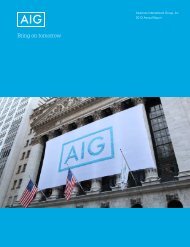2007 Annual Report - AIG.com
2007 Annual Report - AIG.com
2007 Annual Report - AIG.com
Create successful ePaper yourself
Turn your PDF publications into a flip-book with our unique Google optimized e-Paper software.
American International Group, Inc. and Subsidiaries<br />
Management’s Discussion and Analysis of<br />
Financial Condition and Results of Operations Continued<br />
The following table provides information for each reinsurer representing in excess of five percent of <strong>AIG</strong>’s reinsurance assets at<br />
December 31, <strong>2007</strong>:<br />
Gross Percent of Uncollateralized<br />
A.M. General General General<br />
S&P Best Reinsurance Reinsurance Collateral Reinsurance<br />
(in millions) Rating (a) Rating (a) Assets Assets, Net Held (b) Assets<br />
Reinsurer:<br />
Swiss Reinsurance Group AA- A+ $1,818 8.5% $372 $1,446<br />
Berkshire Hathaway Insurance Group AAA A++ $1,618 7.5% $212 $1,406<br />
Munich Reinsurance Group AA- A+ $1,200 5.6% $430 $ 770<br />
Lloyd’s Syndicates — Lloyd’s of London (c) A+ A $1,089 5.1% $113 $ 976<br />
(a) Rating designations as of February 19, 2008.<br />
(b) Excludes collateral held in excess of applicable treaty balances.<br />
(c) Excludes Equitas gross reinsurance assets that are unrated, which are less than five percent of <strong>AIG</strong>’s general reinsurance assets.<br />
(<br />
(<br />
<strong>AIG</strong> maintains an allowance for estimated unrecoverable<br />
cient cash flows to cover contract liabilities in the retirement<br />
reinsurance of $520 million. At December 31, <strong>2007</strong>, <strong>AIG</strong> had no savings-oriented products. Risks are managed through product<br />
significant reinsurance recoverables due from any individual<br />
design, sound medical underwriting, external traditional reinsurreinsurer<br />
that was financially troubled (i.e., liquidated, insolvent, in ance programs and external catastrophe reinsurance programs.<br />
receivership or otherwise subject to formal or informal regulatory <strong>AIG</strong> is a major purchaser of reinsurance for its insurance<br />
restriction).<br />
operations. The use of reinsurance facilitates insurance risk<br />
management (retention, volatility, concentrations) and capital<br />
Segment Risk Management<br />
planning locally (branch and subsidiary). <strong>AIG</strong> may purchase<br />
reinsurance on a pooling basis. Pooling of <strong>AIG</strong>’s reinsurance risks<br />
Other than as described above, <strong>AIG</strong> manages its business risk<br />
enables <strong>AIG</strong> to purchase reinsurance more efficiently at a<br />
oversight activities through its business segments.<br />
consolidated level, manage global counterparty risk and relationships<br />
Insurance Operations<br />
and manage global catastrophe risks, both for the General<br />
Insurance and Life Insurance & Retirement Services businesses.<br />
<strong>AIG</strong>’s multiple insurance businesses conducted on a global basis<br />
expose <strong>AIG</strong> to a wide variety of risks with different time horizons. General Insurance<br />
These risks are managed throughout the organization, both<br />
In General Insurance, underwriting risks are managed through the<br />
centrally and locally, through a number of procedures, including:<br />
application approval process, exposure limitations as well as<br />
(i) pre-launch approval of product design, development and<br />
through exclusions, coverage limits and reinsurance. The risks<br />
distribution; (ii) underwriting approval processes and authorities;<br />
covered by <strong>AIG</strong> are managed through limits on delegated under-<br />
(iii) exposure limits with ongoing monitoring; (iv) modeling and<br />
writing authority, the use of sound underwriting practices, pricing<br />
reporting of aggregations and limit concentrations at multiple<br />
procedures and the use of actuarial analysis as part of the<br />
levels (policy, line of business, product group, country, individdetermination<br />
of overall adequacy of provisions for insurance<br />
ual/group, correlation and catastrophic risk events);<br />
contract liabilities.<br />
(v) <strong>com</strong>pliance with financial reporting and capital and solvency<br />
A primary goal of <strong>AIG</strong> in managing its General Insurance<br />
targets; (vi) extensive use of reinsurance, both internal and thirdoperations<br />
is to achieve an underwriting profit. To achieve this<br />
party; and (vii) review and establishment of reserves.<br />
goal, <strong>AIG</strong> must be disciplined in its risk selection, and premiums<br />
<strong>AIG</strong> closely manages insurance risk by overseeing and controlmust<br />
be adequate and terms and conditions appropriate to cover<br />
ling the nature and geographic location of the risks in each line of<br />
the risk accepted.<br />
business underwritten, the terms and conditions of the underwriting<br />
and the premiums charged for taking on the risk. Concentra- Catastrophe Exposures<br />
tions of risk are analyzed using various modeling techniques and<br />
include, but are not limited to, wind, flood, earthquake, terrorism The nature of <strong>AIG</strong>’s business exposes it to various catastrophic<br />
and accident.<br />
events in which multiple losses across multiple lines of business<br />
<strong>AIG</strong> has two major categories of insurance risks as follows: can occur in any calendar year. In order to control this exposure,<br />
<strong>AIG</strong> uses a <strong>com</strong>bination of techniques, including setting aggregate<br />
General Insurance — risks covered include property, casualty,<br />
fidelity/surety, management liability and mortgage insurance. limits in key business units, monitoring and modeling accumulated<br />
Risks in the general insurance segment are managed through exposures, and purchasing catastrophe reinsurance to suppleaggregations<br />
and limitations of concentrations at multiple levels: ment its other reinsurance protections.<br />
policy, line of business, correlation and catastrophic risk events. Natural disasters such as hurricanes, earthquakes and other<br />
catastrophes have the potential to adversely affect <strong>AIG</strong>’s operat-<br />
Life Insurance & Retirement Services — risks include mortality<br />
and morbidity in the insurance-oriented products and insuffidisease,<br />
ing results. Other risks, such as an outbreak of a pandemic<br />
such as the Avian Influenza A Virus (H5N1),<br />
could<br />
118 <strong>AIG</strong> <strong>2007</strong> Form 10-K

















